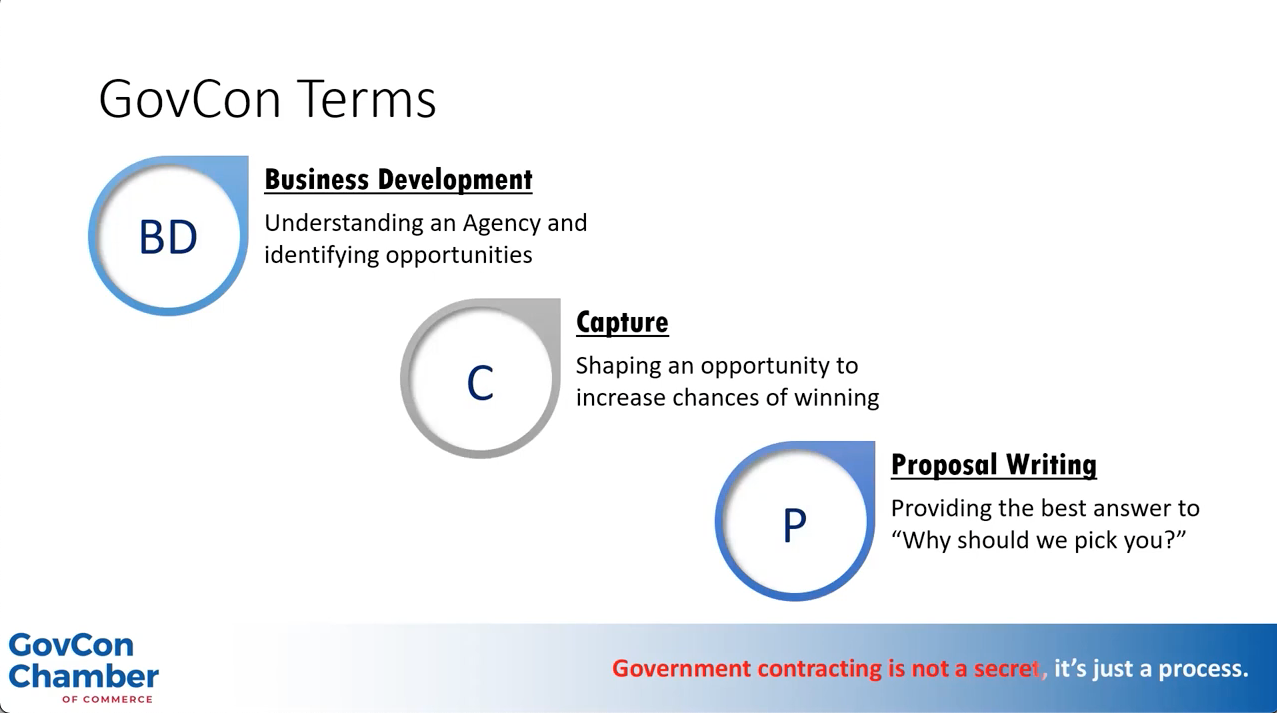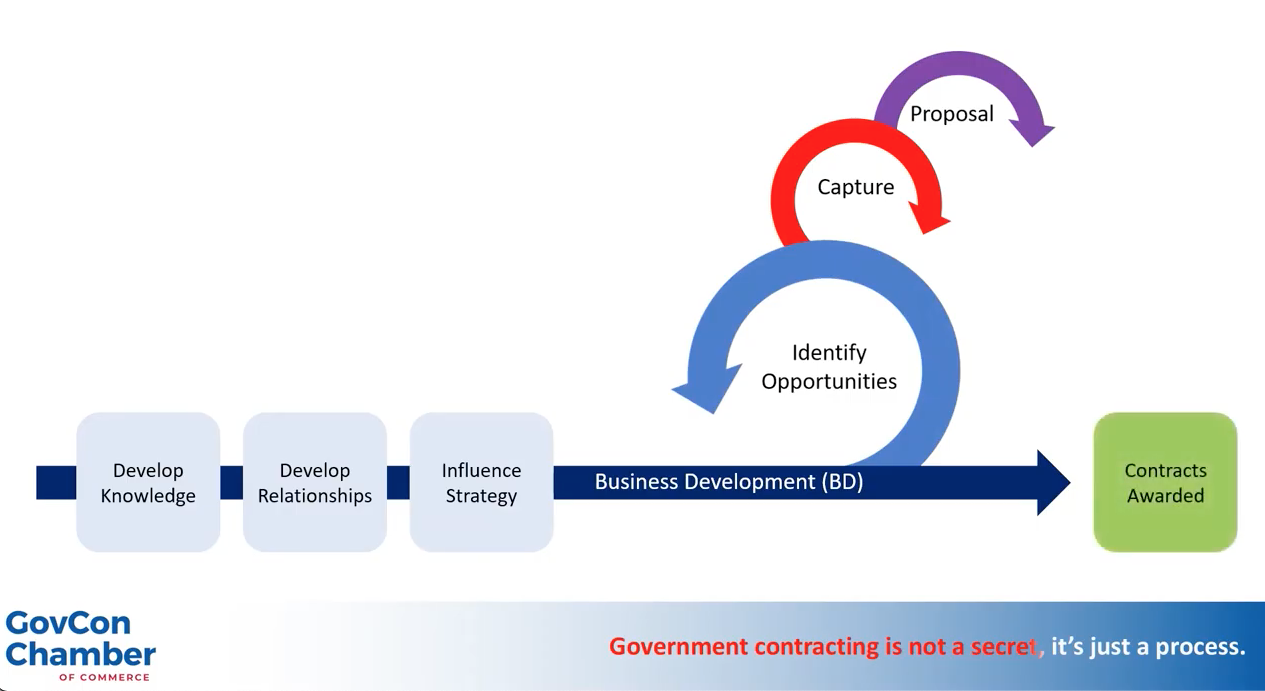Federal Government Sales: A 3 Step Process
Government contracting is not a secret, it’s just a process.
In today’s video I will introduce you the GovCon sales process and key terms such as business development and capture.
ABOUT the GovCon Chamber
This content is brought to you by the GovCon Chamber of Commerce, the only organization dedicated to the success of all small businesses in the federal space, with members from Guam to the U.S. Virgin Islands and every single state in between.
Each year, roughly $125 billion dollars is awarded to small businesses as prime contractors. Our vision is to double that number by helping small businesses truly understand the process for success.
ABOUT our Sponsor
My name is Neil McDonnell and I’ve been where you are now. I’ve been a small business owner for 20 years, building two successful firms selling in the federal market.
I’ve built relationships with small and large firms as a subcontractor. I’ve won prime contracts with defense and civilian agencies.
I’ve done things right and I’ve gotten things wrong. The one thing missing though, for me then and you now, is an easy-to-follow process that will lead to predictable success.
That’s my commitment to you – I’ll provide the process. If you accept responsibility and don’t blame others, you’ll find you have the control to change your future.
SALES RESPONSE TYPES
When selling to the federal government, there are two response types: Bids and Proposals.
BIDS
Bids are generally for products and don’t require a lot of explanation. Examples might include pencils, garbage cans, or software licenses. Basically, bids are won through lowest price.
PROPOSALS
Proposals are much more involved and are provided in response to the government’s need for services such as software development, construction, etc. Proposals are generally won by convincing the buyer that you understand them and have the best approach to their requirement at a reasonable price.
GovCon sales tends to be much more involved when selling services than products, and therefore more dependent on the process I’ll define here.
KEY GOVERNMENT CONTRACTING TERMS
 There are three terms in federal sales that you’ll need to know:
There are three terms in federal sales that you’ll need to know:
- Business Development
- Capture;
- Proposal Writing
Business Development, more often called BD, is a focused approach into one agency. For example, if you’re target customer is the U.S. Coast Guard, then BD is about truly understanding the Coast Guard and identifying any opportunities at that agency.
Capture: If BD is about identifying all opportunities at the Coast Guard, then Capture is about shaping a single opportunity to increase your chances of winning.
Proposal writing: The process where you provide a better answer than your competition to the government’s question, “Why should we pick you?”
GovCon Sales Process: Business Development

All small businesses within the federal government must do business development to achieve success.
BD is an ongoing effort within your primary agency, focusing on this target customer and not any one particular opportunity.
BD includes developing agency knowledge which then enable you to develop agency relationships.
Through those relationships and knowledge, you are then able to influence the agency’s buying strategy.
The final main component of BD is identifying opportunities within your primary agency that fit what your company sells.
When you identify an opportunity that fits what you sell and decide to try and win that contract you’ll start the capture process on that one opportunity.
Finally, when the RFP is posted by the government, you’ll write that winning proposal . All of this activity is designed to help you achieve more contracts being awarded to your company.
Let’s go over these steps in just a little bit more detail.
Developing Agency Knowledge is basically doing your homework on that agency.
You want to understand their mission and long-term strategic goals as well as the short-term objectives they’ll use to measure their own success.
Agencies will often communicate the challenges they’re facing and tie them to one of those strategic goals.
Finally, it’s important that you learn how this agency buys what you sell; for example, do they tend to use GSA for their purchases?
Part of business development is establishing and maintaining relationships with advocates like the small business specialist who can help you learn more about the agency.
Acquisition personnel like the contract specialist or contract officer can talk with you about upcoming opportunities.
And the program office has the folks responsible for the actual work and who establish any new requirements you might support.
By learning about an agency and establishing relationships, you’ll then be able to influence how and what the customer buys. This is basic sales.
You can affect the acquisition approach by asking for a particular set aside or suggesting a contract vehicle to use.
You can influence the technical requirements by suggesting needed certifications or years of experience.
Or you might be able to offer a proof of concept for a very low cost allowing you access to key decision makers in a more collaborative way.
All of this activity will allow you to more accurately identify opportunities that your company can pursue within your primary agency.
As I said, your BD efforts can help you identify opportunities that most of your competitors won’t be aware of yet since you’re in there having the key conversations.
But opportunities can also be identified through the traditional methods as well. You can look in FBO, now in SAM to see the current active opportunities.
You can research opportunities on the agency’s forecast. And you can access FPDS, now in SAM to identify older opportunities you wish you won and start tracking them for when they’ll be recompeted.
GovCon Sales Process: Capture
Capture is about focusing on one single opportunity and doing everything you can to ensure you’ll win the contract.
You’ll work with the program office to shape the requirements and try to have your strengths included in those requirements.
You’ll also work with the contracting shop, trying to shape the acquisition approach – again, whether that’s a particular set aside, years of experience, contract vehicle, etc.
Once the RFP is posted for an opportunity you’ve been performing capture activities on, you’ll begin finalizing a proposal. You want to make sure you understand the customer’s challenges and what they’re trying to solve.
Then make recommendations for your approach to their challenge, including why your approach is best.
Finally, to write a winning proposal, consider getting started earlier than when the RFP drops – during the tail end of the capture is a good time.
REMINDER
BD is about developing your knowledge of an agency and relevant opportunities through homework and relationship building.
Capture is about developing one opportunity, shaping it to give you the best chance at success.
Proposal writing is about answering the question, “Why should we pick you?”
NEXT STEPS
Watch related Neil's LinkedIn live videos
- Federal Capture: How to Form Winning Teams
- Federal Capture: How to Choose the Best Opportunities to Bid On
REMINDER: Click the bell icon on Neil's LinkedIn profile to be notified about upcoming strategic sales training




